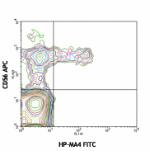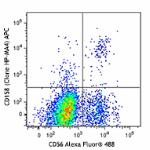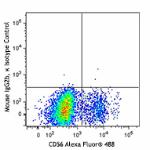- Clone
- HP-MA4 (See other available formats)
- Regulatory Status
- RUO
- Other Names
- CD158a, CD158g, CD158h, KIR2DL1, KIR2DS1, KIR2DS3, KIR2DS5
- Isotype
- Mouse IgG2b, κ
- Barcode Sequence
- TATCAACCAACGCTT
- Ave. Rating
- Submit a Review
- Product Citations
- publications
| Cat # | Size | Price | Quantity Check Availability | Save | ||
|---|---|---|---|---|---|---|
| 339523 | 10 µg | 296€ | ||||
CD158 molecules, also known as KIRs (killer cell immunoglobulin-like receptors), are a family of transmembrane proteins with either two (KIR2D) or three (KIR3D) Ig-like extracellular domains. Some KIRs with long cytoplasmic domains contain ITIMs and posses inhibitory functions and others with short cytoplasmic region lack ITIM and have activation functions. 14 polymorphic KIR genes have been reported in humans. CD158 is mainly expressed on a subset of NK cells and a small population of CD8+ T cells. HLA-C is the ligand of CD158a/h.
Product DetailsProduct Details
- Verified Reactivity
- Human
- Reported Reactivity
- Baboon, Cynomolgus
- Antibody Type
- Monoclonal
- Host Species
- Mouse
- Immunogen
- Human NK cell clone LB2
- Formulation
- Phosphate-buffered solution, pH 7.2, containing 0.09% sodium azide and EDTA
- Preparation
- The antibody was purified by chromatography and conjugated with TotalSeq™-D oligomer under optimal conditions.
- Concentration
- 0.5 mg/mL
- Storage & Handling
- The antibody solution should be stored undiluted between 2°C and 8°C. Do not freeze.
- Application
-
PG - Quality tested
- Recommended Usage
-
Each lot of this antibody is quality control tested by immunofluorescent staining with flow cytometric analysis and the oligomer sequence is confirmed by sequencing. TotalSeq™-D antibodies are compatible with Mission Bio’s Tapestri Single-Cell Sequencing Platform for simultaneous detection of DNA and Protein.
To maximize performance, it is strongly recommended that the reagent be titrated for each application, and that you centrifuge the antibody dilution before adding to the cells at 14,000xg at 2 - 8°C for 10 minutes. Carefully pipette out the liquid avoiding the bottom of the tube and add to the cell suspension. For Proteogenomics analysis, the suggested starting amount of this reagent for titration is ≤ 1.0 µg per million cells in 100 µL volume. Refer to the corresponding TotalSeq™ protocol for specific staining instructions.
Buyer is solely responsible for determining whether Buyer has all intellectual property rights that are necessary for Buyer's intended uses of the BioLegend TotalSeq™ products. For example, for any technology platform Buyer uses with TotalSeq™, it is Buyer's sole responsibility to determine whether it has all necessary third party intellectual property rights to use that platform and TotalSeq™ with that platform. - Application Notes
-
mAb HP-MA4 reacts with KIR2DL1 (CD158a), KIR2DS1 (CD158h), KIR2DS3, and KIR2DS5 (CD158g).
Additional reported applications include: inhibits NK cell mediated cytotoxicity and immunoprecipitation.
This clone has been tested in-house and determined to not be suitable for applications in immunohistochemistry of paraffin-embedded tissue sections (IHC-P). - Additional Product Notes
-
TotalSeq™-D reagents are designed to profile protein expression at single cell level. The Mission Bio Tapestri platform and sequencer (e.g. Illumina analyzers) are required. Please contact technical support for more information, or visit biolegend.com/totalseq/single-cell-dna
The barcode flanking sequences are CGAGATGACTACGCTACTCATGG (PCR handle), and GAGCCGATCTAGTATCTCAGT*C*G (capture sequence). * indicates a phosphorothioated bond, to prevent nuclease degradation.
View more applications data for this product in our Application Technical Notes. -
Application References
(PubMed link indicates BioLegend citation) -
- De Miguel M and M. Lopez-Botet. 2002. Inmunologia. 21:187
- Goodridge JP, et al. 2013. J. Immunol. 191:3553. PubMed
- RRID
-
AB_3675061 (BioLegend Cat. No. 339523)
Antigen Details
- Structure
- Contains two Ig-like extracellular domains, 58/50 kD
- Distribution
-
Subset of NK cells and a small subset of CD8+ T cells
- Function
- Inhibits NK cell function, play a role in self-tolerance.
- Ligand/Receptor
- HLA-C
- Cell Type
- NK cells, T cells
- Biology Area
- Immunology, Inhibitory Molecules
- Molecular Family
- CD Molecules
- Antigen References
-
1. Zola H, et al. eds. 2007. Leukocyte and Stromal Cell Molecules:The CD Markers. Wiely-Liss A John Wiley & Sons Inc, Publication
- Gene ID
- 3802 View all products for this Gene ID 3810 View all products for this Gene ID 3808 View all products for this Gene ID 3806 View all products for this Gene ID
- UniProt
- View information about CD158 on UniProt.org
Related Pages & Pathways
Pages
Related FAQs
Other Formats
View All CD158 Reagents Request Custom Conjugation| Description | Clone | Applications |
|---|---|---|
| PE anti-human CD158 (KIR2DL1/S1/S3/S5) | HP-MA4 | FC |
| Purified anti-human CD158 (KIR2DL1/S1/S3/S5) | HP-MA4 | FC,IP |
| FITC anti-human CD158 (KIR2DL1/S1/S3/S5) | HP-MA4 | FC |
| PerCP/Cyanine5.5 anti-human CD158 (KIR2DL1/S1/S3/S5) | HP-MA4 | FC |
| PE/Cyanine7 anti-human CD158 (KIR2DL1/S1/S3/S5) | HP-MA4 | FC |
| APC anti-human CD158 (KIR2DL1/S1/S3/S5) | HP-MA4 | FC |
| TotalSeq™-A0420 anti-human CD158 (KIR2DL1/S1/S3/S5) | HP-MA4 | PG |
| TotalSeq™-C0420 anti-human CD158 (KIR2DL1/S1/S3/S5) | HP-MA4 | PG |
| APC/Fire™ 750 anti-human CD158 (KIR2DL1/S1/S3/S5) | HP-MA4 | FC |
| TotalSeq™-B0420 anti-human CD158 (KIR2DL1/S1/S3/S5) Antibody | HP-MA4 | PG |
| TotalSeq™-D0420 anti-human CD158 (KIR2DL1/S1/S3/S5) Antibody | HP-MA4 | PG |
Compare Data Across All Formats
This data display is provided for general comparisons between formats.
Your actual data may vary due to variations in samples, target cells, instruments and their settings, staining conditions, and other factors.
If you need assistance with selecting the best format contact our expert technical support team.
-
PE anti-human CD158 (KIR2DL1/S1/S3/S5)

Human peripheral blood lymphocytes were stained with CD56 AP... -
Purified anti-human CD158 (KIR2DL1/S1/S3/S5)

Human peripheral blood lymphocytes were stained with CD56 AP... -
FITC anti-human CD158 (KIR2DL1/S1/S3/S5)

Human peripheral blood lymphocytes stained with HP-MA4 FITC ... -
PerCP/Cyanine5.5 anti-human CD158 (KIR2DL1/S1/S3/S5)

Human peripheral blood lymphocytes were stained with CD56 Al... -
PE/Cyanine7 anti-human CD158 (KIR2DL1/S1/S3/S5)

Human peripheral blood lymphocytes were stained with CD56 Al... -
APC anti-human CD158 (KIR2DL1/S1/S3/S5)

Human peripheral blood lymphocytes were stained with CD56 Al... 
-
TotalSeq™-A0420 anti-human CD158 (KIR2DL1/S1/S3/S5)
-
TotalSeq™-C0420 anti-human CD158 (KIR2DL1/S1/S3/S5)
-
APC/Fire™ 750 anti-human CD158 (KIR2DL1/S1/S3/S5)

Human peripheral blood lymphocytes were stained with CD56 AP... -
TotalSeq™-B0420 anti-human CD158 (KIR2DL1/S1/S3/S5) Antibody
-
TotalSeq™-D0420 anti-human CD158 (KIR2DL1/S1/S3/S5) Antibody
 Login / Register
Login / Register 













Follow Us